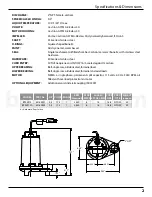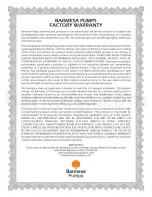
4
Installation & Service
Both a check valve and a shut-off
valve are recommended for each
pump. The check valve is used to
prevent backflow into the sump. The
shut-off valve is used to manually
stop system low during pump
servicing.
4
Electrical Connections
Power cable:
The power cable mounted to the
pump must not be modified in any
way. This pump is provided with a 3
wire cord and 3 prong grounded
plug that must be connected into a 3
wire
grounded
Ground
Fault
receptacle. Do not bypass grounding
wires or remove ground prongs from
plug. This pump requires separate,
properly fused and grounded branch
circuit. Use of a ground fault circuit
interrupter
(GFCI)
is
strongly
recommended.
The electrical outlet or panel shall be
within the length limitations of the
pump power cord, and at least 4 feet
above floor level to minimize
possible
hazards
from
flood
conditions. Do Not use an extension
cord.
IF USED with Control Panel -
Any
splice between the pump and the
control panel must be made in
accordance with the electric codes. It
is recommended that a junction box,
if used, be mounted outside the
sump or be of at a minimum NEMA 4
construction if located within the wet
well.
DO NOT USE THE POWER
CABLE TO LIFT PUMP
. Always rely
upon a Certified Electrician for
installation.
This means that the overload
protector will trip out and shut the
pump off if the windings become too
hot, or the load current passing
through them becomes too high.
IMPORTANT! -
The overload will then
automatically reset and start the
pump up after the motor cools to a
safe temperature. In the event of an
overload, the source of this condition
should be determined and corrected
immediately.
DO NOT ALLOW THE
PUMP TO CYCLE OR RUN IF AN
OVERLOAD CONDITION OCCURS.
WARNING
If current through the temperature
sensor exceeds the values listed, an
intermediate control circuit relay
must be used to reduce the current
or the sensor will not work properly.
TEMPERATURE SENSOR ELECTRICAL
RATINGS
Volts
Continuous
Amperes
Inrush
Amperes
110-120
3.00
30.0
220-240
1.50
15.0
Wire Size:
If longer power cable is required
consult a qualified electrician for
proper wire size.
4
Pre-Operation
1.
Check Voltage and Phase -
Compare the voltage and phase
information stamped on the
pump name plate.
2.
Check Pump Rotation -
Improper
motor rotation can result in poor
pump performance and can
damage the motor and/or pump.
Incorrect rotation for Single-Phase
pumps is unlikely. If the rotation is
incorrect contact factory.
3.
Name Plate -
Record the
information from the pump name
plate to drawing in front of
manual for future reference.
4.
Insulation Test -
An insulation
(megger)
test
should
be
performed on the motor. Before
the pump is put into service. The
resistance values (ohms) as well
as the voltage (volts) and current
(amps) should be recorded.
5.
Pump-Down Test -
Be sure pump
has been properly wired, lowered
into the basin, sump or lift station,
check the system by filling with
liquid and allowing the pump to
operate through its pumping
cycle. The time needed to empty
the system, or pump-down time
along with the volume of water,
should be recorded.
No lubrication or maintenance is
required. Perform the following
checks when pump is removed from
operation
or
when
pump
performance deteriorates:
4
Maintenance
a) Inspect motor chamber for oil level
and contamination.
b) Inspect impeller and body for
excessive build-up or clogging.
c) Inspect motor, bearings and shaft
seal for wear or leakage.
Overload Protection:
Single Phase
- The stator in-winding
overload protector used is referred to
as an inherent overheating protector
and operates on the combined effect
of temperature and current.
Cooling Oil -
Anytime the pump is
removed from operation, the cooling
oil in the motor housing should be
checked visually for oil level and
contamination.
4
Servicing
To check oil, set unit upright. Remove
pipe plug from housing.
barmesa.com
Summary of Contents for BPEV512 Series
Page 11: ...10 barmesa com...





























